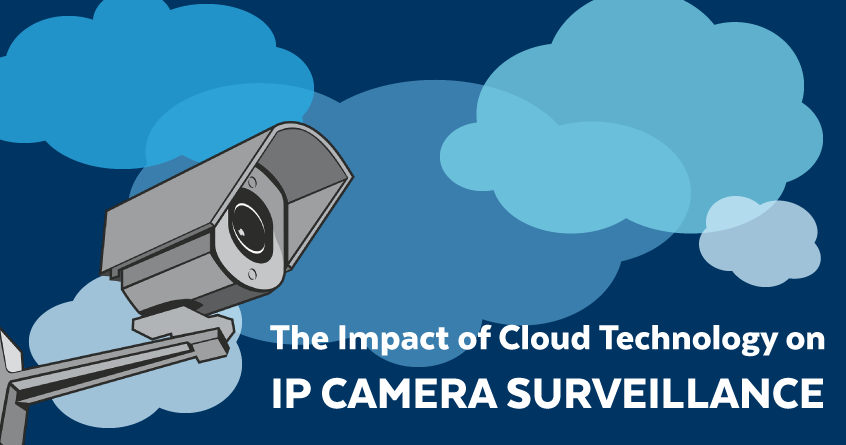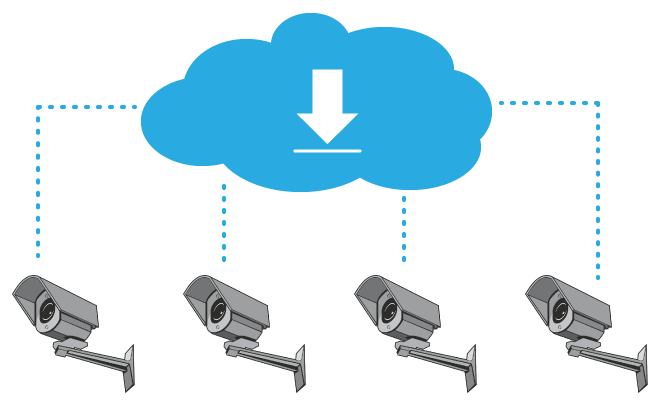In the days before IP camera surveillance appeared on the market, security systems usually relied on video cameras and recording devices. Strategic camera positioning was more like directing a Hollywood movie than preventing theft and enhancing security. Security footage would usually be recorded and stored in on-site equipment, leaving it vulnerable to human error, accidental damage, and even destruction by those the system was designed specifically to catch. Burglars could destroy or remove recording devices from the site. Employees with access could tamper with recording media to prevent internal investigations. Natural disasters such as flooding or fire meant entire volumes of archived tapes could be destroyed in a single moment.
As technology advanced, so did the methods of storing footage. Videotapes became SSD cards and microSD storage. Hard disk storage and even Zip drives meant information could be stored digitally with Blu-Ray and DVD backups. Yet, even these storage platforms had their limits. All that changed with the introduction of cloud technology and IP camera surveillance.
How Is Cloud Technology Used in IP Camera Surveillance?
Security improves as more information is gathered through a surveillance system. Collecting all of this data has historically meant that the limitations of the media, such as image/sound quality and frames per second, quickly fill up available storage space, usually increasing the time it would take to retrieve information. With cloud technology, there are almost no limits to IP camera surveillance.
Unlike on-site storage systems such as servers, hard disks, or SD cards, cloud storage isn’t hobbled by the limitations of the size of the storage volume. Cloud storage works by using a series of storage arrays located off-site. The data is stored and indexed in an array, made up of multiple networks of secured servers with incredible amounts of storage space. These arrays specialize in holding data and are built to provide quick access to it, all through automated processes, unlike having to sort through files or thumb drive yourself. Compared to buying extra hard drive space, cloud-based storage only costs pennies per megabyte.
Improved IP Camera Surveillance Performance through Cloud Technology
What are some of the advantages of using cloud technology for IP camera surveillance?
- Enhanced storage capacity: The nearly limitless amounts of storage space on the cloud mean that you will never run out of room to store vital IP surveillance data.
- Improved accessibility: Advanced indexing software means that you can find the footage you are looking for in a matter of seconds, instead of loading and unloading storage volumes as you search.
- Efficient bandwidth management: The resolution and speed of your IP camera surveillance footage is determined by the bandwidth of data being stored. The cloud allows for individual configuration to meet your security needs.
- Robust data security: Not only is your IP security footage being stored on the cloud, so is a lot of other information from different users. The most advanced security protocols are in place, ensuring that your information is kept secure.
- Intelligent video analytics: Advanced algorithms make sure that you have the most control over what is being recorded, such as camera sensitivity, motion detection, IR lighting, and even facial recognition.
- Seamless integration and collaboration: With administrative access, you decide who has access to the surveillance system, whether while accessing the system on-site or remotely via your smartphone, half a world away!
Cloud Enhances Storage Capacity
Using cloud technology eliminates local storage limitations. It also allows for surveillance footage that needs to be captured in less than ideal conditions, where installation might otherwise damage conventional on-site storage. Temperature, humidity, and other environmental factors are no longer risk factors when the footage is stored in a cloud system located hundreds of miles away.
The potential for unlimited storage capacity in the cloud also means that more cameras can be used from multiple angles to give you a comprehensive image of the area. The cloud gives you the ability to store high-resolution videos for longer durations. You won’t have to worry about formatting old storage media and potentially deleting archived footage you may later need.
Cloud Helps Improve Accessibility
Whether you are on-site full-time or find yourself working in the field or even traveling, all modern workers understand the importance of having remote access to live and recorded video footage. When you can access it anywhere, at any time, using internet-connected devices, you are truly in control of your surveillance systems in real time.
Remote monitoring keeps your finger on the pulse of any situation. With real-time, remote monitoring via cloud technology, security measures can be put into place. This includes everything from loss prevention to fire control.
Improves Bandwidth Management Efficiency
Due to the limitations of on-site storage, security used to be limited to what was vital, leaving blind spots in the monitored area as well as limitations to how much bandwidth could be dedicated for each camera. Cloud technology allows IP cameras to be set to ignore certain areas which would trigger unnecessary recording, as well as sensitivity to what should initiate a recording.
Only what is relevant will be transferred to the cloud, improving your ability to filter what is important to review from what can be dismissed. Analysis and storage conditions are based on predefined criteria that you establish, which in turn reduces network congestion and promotes efficient bandwidth implementation.
Makes Data Security More Robust 
The encryption protocols and security measures in cloud storage systems are vital for protecting users against unauthorized access and tampering. Intruders can not only pose a threat to your system, they can also physically damage your surveillance systems on-site. Would-be intruders often do this to cover their tracks and avoid identification.
Being off-site has other benefits as well when it comes to the potential for in-house disruption of security and data. No one likes to admit that their employees could be a potential threat to security, which is why cloud technology eliminates access to storage systems on-site and eliminates loss risks.
IP Camera Surveillance and Intelligent Video Analytics
Real-time video processing and analysis in the cloud will give you greater control when it comes to what is imaged, stored, and archived. Here are some of the ways video analytics can improve the efficiency of an IP camera-based surveillance system.
- Facial recognition
- Object detection
- Behavioral analysis
- Automation of monitoring tasks and actionable insights
Allows Seamless Integration and Collaboration
Integration with cloud-based management platforms provide admins with a means for accessing and controlling cameras along with other business operations. Efficient monitoring and management of multiple sites or locations reduces the need for multiple security teams and also reduces oversight and human error. Many security breaches and leaks have been attributed to having multiple systems, administrators, and on-site users lost in the process of juggling between different platforms. With the cloud, all information can be made available in real time to the right users at any time. This kind of technology can go a long way to eliminating communication problems and fostering a consistent security workflow.
Why Move IP Camera Surveillance Implementation to The Cloud?
As technology improves, capable security managers need to keep up with the ways criminals can circumvent sophisticated security systems. IP camera surveillance already provides a way to document and observe areas that need to be protected, but those who try to threaten these systems have a number of tricks to get around older systems and remain undetected. Cloud technology not only gives you more control and uniformity in how security systems are designed, it also provides an added layer of security by keeping all data off-site to eliminate the destruction of that information.
Cloud technology also provides the user with the ease and convenience of having access to real-time information and archived footage anywhere you have access to the internet. Even though access is easier for the user, the information held in the cloud is protected and kept indefinitely if desired. Using cloud technology for IP camera surveillance is like having your security systems guarded as they guard your assets. Staying ahead of the curve is crucial if you want to protect your investments. Cloud technology gives its users the peace of mind of knowing that they have an eye on their establishments at all times, ensuring the safety, security, and liability of their business.


